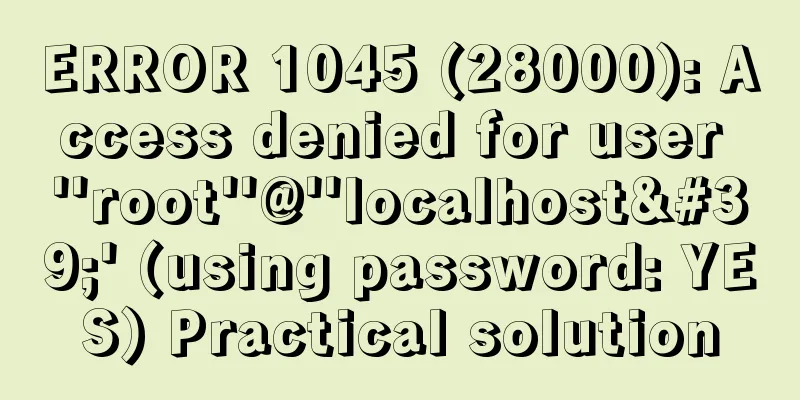MySQL cross-table query and cross-table update

|
Friends who have some basic knowledge of SQL must have heard of "cross-table query", but what is cross-table update? background The project has imported a new batch of personnel data. Some of these people's department names have changed, and some of their contact information has changed. Let's call this table Silly SQL is killed instantly Without thinking, I wrote the following SQL
Seeing DBA Xiao Duan behind me practicing, I thought of asking him to help polish it 😜, so I sent it to him, and then it came back like this:
I was stunned when I saw this SQL statement. How could it be written like this? Under the merciless ridicule, I fell to the ground with a "KO". You have to die knowingly. We have to find out what's going on. Mysql Update Join We often use Similarly, in MySQL, we can also use the JOIN clause in the UPDATE statement to perform cross-table updates. The syntax is as follows: UPDATE T1, T2, [INNER JOIN | LEFT JOIN] T1 ON T1.C1 = T2.C1 SET T1.C2 = T2.C2, T2.C3 = expr WHERE condition Let's explain the above syntax in detail: First, after the UPDATE clause, specify the primary table (T1) and the table (T2) to which you want the primary table to be joined. Note that you must specify at least one table after the UPDATE clause. Next, specify the type of join you want to use, either INNER JOIN or LEFT JOIN, and the join predicate. The JOIN clause must appear after the UPDATE clause (everyone knows this). Then, assign new values to the columns in the T1 or T2 table to be updated. Finally, specify a condition in the WHERE clause to limit the rows to those to be updated. If you follow the update syntax, you will find that there is another syntax that can also complete cross-table updates UPDATE T1, T2 SET T1.c2 = T2.c2, T2.c3 = expr WHERE T1.c1 = T2.c1 AND condition The above syntax actually implicitly uses the inner join keyword, which is exactly equivalent to the following: UPDATE T1,T2 INNER JOIN T2 ON T1.C1 = T2.C1 SET T1.C2 = T2.C2, T2.C3 = expr WHERE condition My personal suggestion is to add the I saw this while joking around, and I think it's a soul translation Update Join Example It’s the end of the year, and it’s time to evaluate performance, that thing called KPI (do you have it?). I heard that salaries will be adjusted based on KPI. There are two tables The first table is "employees"
The table creation statement is as follows:
create table employees
(
employee_id bigint auto_increment comment 'Employee ID, primary key',
employee_name varchar(50) null comment 'Employee name',
performance int(4) null comment 'Performance score 1, 2, 3, 4, 5',
salary float null comment 'Employee salary',
constraint employees_pk
primary key (employee_id)
)
comment 'employee table';
The second table is "merits-performance dictionary table"
The table creation statement is as follows: create table merits ( performance int(4) null, percentage float null ) comment 'Performance dictionary table'; Generate some simulated data first
-- Initialize the performance dictionary data INSERT INTO merits(performance, percentage)
VALUES (1, 0),
(2, 0.01),
(3, 0.03),
(4, 0.05),
(5, 0.08);
-- Initialize data in employee table INSERT INTO employees(employee_name, performance, salary)
VALUES ('Gong Ge', 1, 1000),
('Xiao Duanzong', 3, 20000),
('Adult', 4, 18000),
('Commander', 5, 28000),
('Old Six', 2, 10000),
('Romon', 3, 20000);
Salary adjustment rules: Write update statements according to salary adjustment rules: UPDATE employees INNER JOIN merits ON employees.performance = merits.performance SET salary = salary + salary * percentage;
Gong Ge's performance was not good, so he didn't get a raise... Three horizontal lines, one vertical line, and one cuckoo, four little pigs come to eat zha, cuckoo cuckoo, two more come Near the end of the year, two new colleagues joined the company, but the company's annual performance evaluation has been completed, so the new employees' performance is NULL
INSERT INTO employees(employee_name, performance, salary)
VALUES ('冯大', NULL, 8000),
('冯二', NULL, 5000);
If the new employee does a good job, he or she should also get a UPDATE employees LEFT JOIN merits ON employees.performance = merits.performance SET salary = salary + salary * 0.015 WHERE merits.percentage IS NULL;
At this point, the salary increase for new employees was also completed. Gong Ge went home to celebrate the New Year in shame because he did not have a thorough understanding of the knowledge points. You may also be interested in:
|
<<: Vue implements user login and token verification
>>: Nexus uses nginx proxy to support HTTPS protocol
Recommend
Example analysis of the impact of MySQL index on sorting
This article uses examples to illustrate the impa...
Problems and solutions of error 08001 when linking to MySQL in IDEA and no table display after successful connection
Error: Connection to blog0@localhost failed. [080...
CSS removes the dotted border generated when clicking a link. Compatible with browsers that meet W3C standards
Part of the code: Copy code The code is as follow...
How to find the specified content of a large file in Linux
Think big and small, then redirect. Sometimes Lin...
How to make a website front end elegant and attractive to users
The temperament of a web front-end website is a fe...
Detailed steps to build the TypeScript environment and deploy it to VSCode
Table of contents TypeScript environment construc...
Correct way to write empty links to prevent page jumps after clicking a href # problem
Sometimes you need to use links, but you don't...
HTML form tag tutorial (2):
This tutorial introduces the application of vario...
Detailed explanation of how to install PHP7 on Linux
How to install PHP7 on Linux? 1. Install dependen...
How to customize Docker images using Dockerfile
Customizing images using Dockerfile Image customi...
Let's talk about destructuring in JS ES6
Overview es6 adds a new way to get specified elem...
MySql 5.6.36 64-bit green version installation graphic tutorial
There are many articles about MySQL installation ...
Detailed code for adding electron to the vue project
1. Add in package.json "main": "el...
Detailed graphic explanation of how to clear the keep-alive cache
Table of contents Opening scene Direct rendering ...
Detailed explanation of the use of bus in Vue
Vue bus mechanism (bus) In addition to using vuex...
















